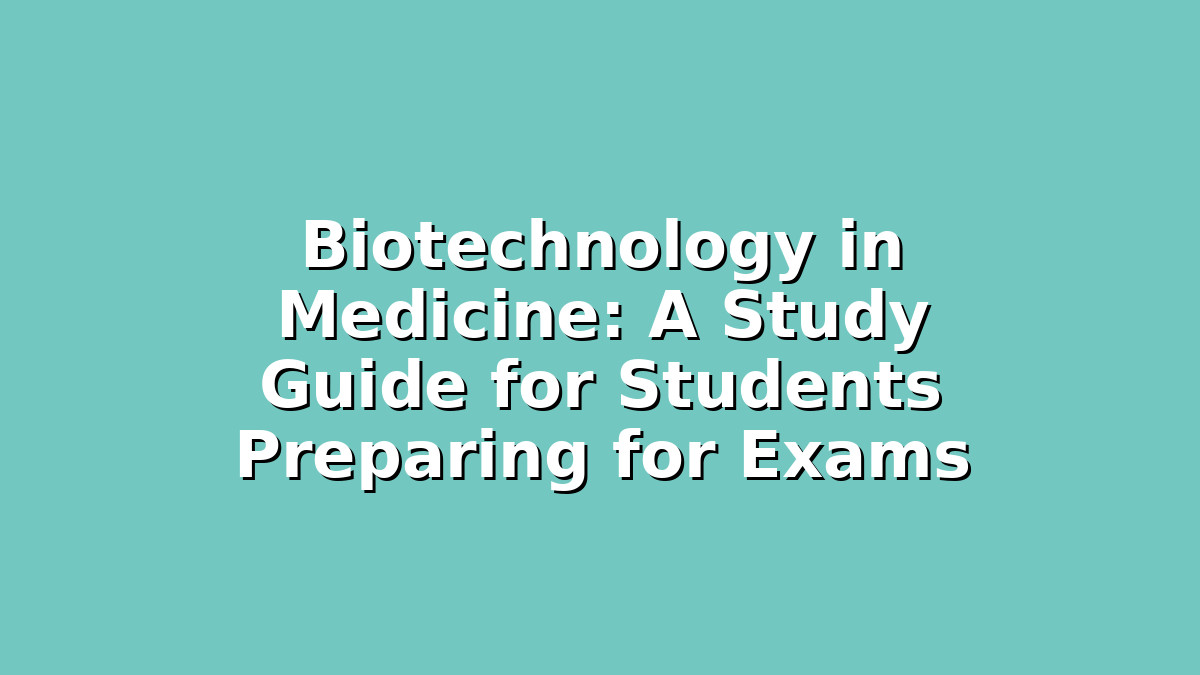Biotechnology has revolutionized the field of medicine, offering groundbreaking solutions for diagnosing, treating, and preventing diseases. For students preparing for exams, especially those focused on biology, medicine, or related sciences, understanding biotechnology’s role in medicine is not only fascinating but essential. This article will guide you through the core concepts of biotechnology in medicine, provide effective study strategies, and help you confidently tackle exam questions on this topic.
Introduction: Why Biotechnology in Medicine Matters to Students
Biotechnology combines biology and technology to develop products and technologies that improve human health. From genetic engineering to personalized medicine, biotechnology has transformed medical research and clinical practices. As a student, mastering this subject will deepen your understanding of modern healthcare and prepare you for future careers in science and medicine.
However, biotechnology can be complex, with many technical terms and concepts. The key to success lies in breaking down the topic into manageable parts and applying effective study techniques. Let’s explore three essential areas: core concepts you need to know, how to approach complex processes, and tips for retaining detailed information.
—
1. Grasping Core Concepts: The Foundation of Biotechnology in Medicine
Before diving into advanced topics, ensure you have a solid grasp of the foundational concepts. Key areas include:
– Genetic Engineering and Recombinant DNA Technology: Understand how scientists manipulate DNA to produce medicines like insulin or create gene therapies.
– Monoclonal Antibodies: Learn how these lab-produced molecules can target specific cells, revolutionizing treatments for diseases like cancer.
– Stem Cell Technology: Know the role of stem cells in regenerative medicine and their potential to repair damaged tissues.
– Pharmacogenomics: Explore how genetic differences influence drug responses, leading to personalized medicine.
– Biotechnology in Diagnostics: Study techniques like PCR (Polymerase Chain Reaction) and ELISA (Enzyme-Linked Immunosorbent Assay) used for detecting diseases.
Study Tip: Create concept maps linking these ideas. Visualizing relationships helps memory retention and clarifies how different technologies contribute to medical advancements. Use diagrams from textbooks or online resources to reinforce your understanding of processes like DNA cloning or PCR amplification.
—
2. Breaking Down Complex Processes: Step-By-Step Learning
Biotechnological methods often involve multi-step procedures, which can be overwhelming. To prepare well for exams, break down each process into simple, logical steps. For example:
– Recombinant DNA Technology Process:
1. Isolation of the gene of interest.
2. Insertion of the gene into a vector (like a plasmid).
3. Introduction of the vector into a host organism (e.g., bacteria).
4. Cloning and expression of the gene to produce the desired protein.
– Polymerase Chain Reaction (PCR):
1. Denaturation (heating to separate DNA strands).
2. Annealing (cooling to allow primers to bind).
3. Extension (DNA polymerase synthesizes new strands).
By approaching each method step-by-step, you can better understand the reasoning behind each stage and anticipate questions that test your comprehension.
Study Tip: Write out these processes repeatedly or teach them to a peer. Explaining complex procedures aloud not only reinforces your knowledge but reveals any gaps in understanding.
—
3. Retaining Details and Applying Knowledge: Memory Techniques and Practice
Biotechnology in medicine involves remembering many details—enzyme names, stages of processes, and medical applications. Use active learning strategies to maximize retention and apply what you’ve learned:
– Flashcards: Create flashcards with biotechnology terms on one side and definitions or explanations on the other. Apps like Anki or Quizlet offer spaced repetition systems perfect for long-term memorization.
– Practice Questions: Attempt past exam questions or quizzes focused on biotechnology and medicine. This familiarizes you with typical question formats and strengthens your recall under time pressure.
– Relate to Real-Life Applications: Connect theoretical concepts to real-world examples, such as how CRISPR gene editing is being used to treat genetic disorders. This not only deepens understanding but also makes studying more interesting and relevant.
– Summarize and Review: After studying each section, write a brief summary in your own words. This reinforces learning and provides quick review material before exams.
Study Tip: Balance memorization with conceptual understanding. Instead of rote learning, focus on “why” and “how” biotechnology techniques work and their impacts on medicine.
—
Conclusion: Stay Curious and Confident
Biotechnology in medicine is a dynamic, ever-evolving field that offers exciting career opportunities and crucial medical breakthroughs. For exam preparation, focus on building a strong foundation of core concepts, breaking down complex processes into manageable steps, and employing active learning techniques to retain details.
Remember, consistent study, curiosity, and practice are your best tools. Don’t hesitate to seek help from teachers or study groups when concepts seem challenging. With dedication and the right approach, you’ll not only excel in your exams but also gain a deeper appreciation for how biotechnology is shaping the future of medicine.
Keep pushing forward — your efforts will pay off!
—

Responses